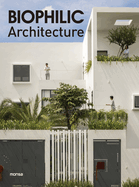Biophilic Architecture
- Unit price
- / per
-
Author:MINGUET Anna
-
ISBN:9788417557683
-
Publication Date:January 2024
-
Edition:1
-
Pages:144
-
Binding:Hardback
-
Publisher:MONSA
-
Country of Publication:Spain


Biophilic Architecture
- Unit price
- / per
-
Author:MINGUET Anna
-
ISBN:9788417557683
-
Publication Date:January 2024
-
Edition:1
-
Pages:144
-
Binding:Hardback
-
Publisher:MONSA
-
Country of Publication:Spain
Description
Biophilic architecture integrates nature into spaces and buildings to improve people's health and well-being. It is based on the idea that humans are innately connected with nature and that exposure to natural elements, such as sunlight, water, and plants, can positively impact our physical and mental health and, thus, our social well-being. Biophilic architecture can be applied in various environments, from office buildings to homes and public spaces. Some common characteristics of biophilic architecture include the incorporation of natural light and ventilation, the presence of green areas, and the use of natural materials such as wood and stone. In addition to improving health and providing comfort, biophilic architecture also has environmental benefits by reducing the carbon footprint and promoting sustainable practices.
Adding product to your cart
You may also like
You may also like
You may also like
-
Biophilic architecture integrates nature into spaces and buildings to improve people's health and well-being. It is based on the idea that humans are innately connected with nature and that exposure to natural elements, such as sunlight, water, and plants, can positively impact our physical and mental health and, thus, our social well-being. Biophilic architecture can be applied in various environments, from office buildings to homes and public spaces. Some common characteristics of biophilic architecture include the incorporation of natural light and ventilation, the presence of green areas, and the use of natural materials such as wood and stone. In addition to improving health and providing comfort, biophilic architecture also has environmental benefits by reducing the carbon footprint and promoting sustainable practices.
-
-
Author: MINGUET AnnaISBN: 9788417557683Publication Date: January 2024Edition: 1Pages: 144Binding: HardbackPublisher: MONSACountry of Publication: Spain
Biophilic architecture integrates nature into spaces and buildings to improve people's health and well-being. It is based on the idea that humans are innately connected with nature and that exposure to natural elements, such as sunlight, water, and plants, can positively impact our physical and mental health and, thus, our social well-being. Biophilic architecture can be applied in various environments, from office buildings to homes and public spaces. Some common characteristics of biophilic architecture include the incorporation of natural light and ventilation, the presence of green areas, and the use of natural materials such as wood and stone. In addition to improving health and providing comfort, biophilic architecture also has environmental benefits by reducing the carbon footprint and promoting sustainable practices.
-
Author: MINGUET AnnaISBN: 9788417557683Publication Date: January 2024Edition: 1Pages: 144Binding: HardbackPublisher: MONSACountry of Publication: Spain
-




